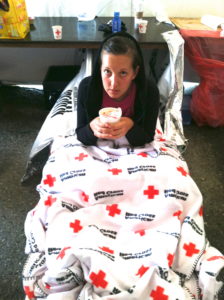I seem to be the target of weird weather situations for races this year. This past weekend, I ran the Nike Women’s Half Marathon in San Francisco, CA. I’ve done this race a few times and the weather is usually really nice. However, the fog seemed a little more dense than usual. I thought I was having a really great race, but I somehow ended up visiting the fine Red Cross and Kaiser Permanente volunteers in the medical tent…I say, “somehow ended up” because frankly, the sequence of events leading up to that point were about as foggy as San Francisco itself.
Let’s first cover a few of the symptoms of hypothermia:
Shivering
Clumsiness or lack of coordination
Slurred speech or mumbling
Stumbling
Confusion or difficulty thinking
Poor decision making, such as trying to remove warm clothes
Drowsiness or very low energy
Apathy or lack of concern about one’s condition
Progressive loss of consciousness
Weak pulse
Slow, shallow breathing
According to the person I was running with, I covered at least half of those symptoms when we crossed the finish line. You see, hypothermia can strike even if you’re doing something active when it’s chilly outside. It’s all about what you’re wearing and how much you’re sweating.
When sweat doesn’t evaporate fast enough, it makes your clothes damp, and when your cold, damp clothes are constantly in contact with your skin, you begin to cool down as well. You can start to develop these symptoms because your body is trying to keep its core functions (like brain and heart) alive.
This is how the rest of the event went (so I was told)…Once in the medical tent, I was directed to a cot, and my running partner was asked a good list of questions about my symptoms. The medical team then did some quick tests to see how I was doing. Apparently, I failed the “Tell the doctor how many fingers he was holding up” test, and they didn’t like my answer when they asked me what the date was (I eventually said Sunday, I’m guessing now that they wanted the day and month!). And to top it off, I failed the thermometer test too..I was a few degrees below 98.6.
 After failing these tests, the staff pulled as many of my wet clothes off of me as possible, wrapped me up in a bunch of Red Cross blankets, and when I had warmed up a little bit, they put me in this awesome “heat tunnel” – which is when my brain started to defog and I started to feel normal. Luckily, I always keep dry clothes in my post-race bag that met us at the finish, so I was able to get into something dry before we left. Lastly, they sent me off with some really hot soup and a blanket.
After failing these tests, the staff pulled as many of my wet clothes off of me as possible, wrapped me up in a bunch of Red Cross blankets, and when I had warmed up a little bit, they put me in this awesome “heat tunnel” – which is when my brain started to defog and I started to feel normal. Luckily, I always keep dry clothes in my post-race bag that met us at the finish, so I was able to get into something dry before we left. Lastly, they sent me off with some really hot soup and a blanket.
So if you’re going to be active when the temperatures start dropping, think ahead so you know you’ll have a safe winter:
1) Layer your clothes so sweat has a better chance of getting off of your skin. 2) Consider wearing a hat so that precious heat doesn’t quickly escape.
3) If you’re not going directly home after working out, have dry clothes stashed in your car or finish area to change into immediately after you finish
4) Lastly, workout with a buddy who’s First Aid certified…they’ll know when to walk you to the Med Tent…
A huge thank you to the volunteers of the Red Cross Bay Area Chapter and Kaiser Permanente – as much as I didn’t want to be in the Med Tent, you were all very kind and caring, I knew I was in good hands.
